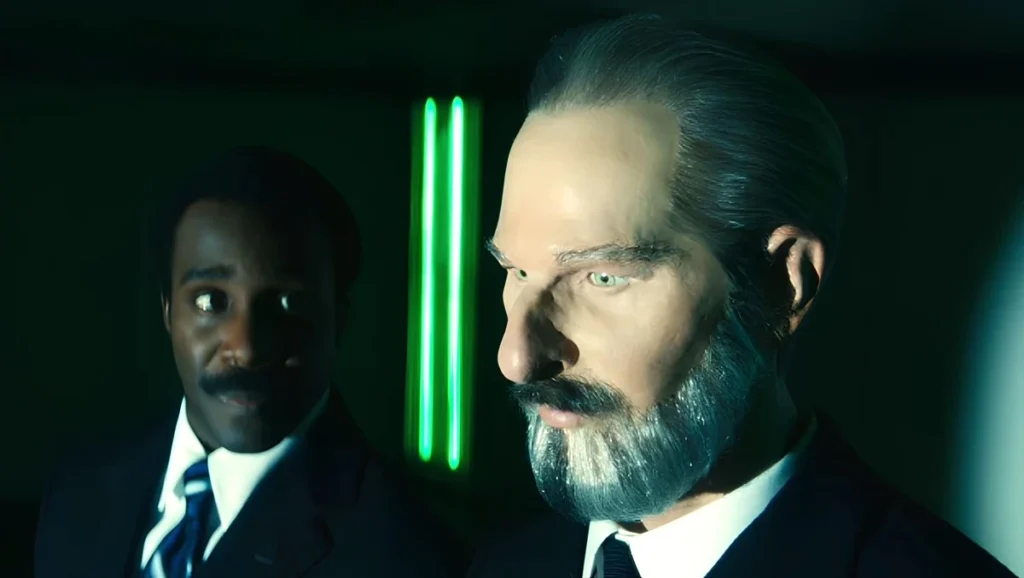Introduction: the company that controls everything, yet no one really knows
Anyone watching Severance quickly realizes that Lumon Industries is not just a backdrop — it’s the core of the story. With its white hallways, strange rituals, and strict rules, the company where the protagonists work feels like a corporate nightmare come to life.
But what exactly is Lumon? And why does it behave more like a cult than a regular organization?
What makes Lumon Severance so disturbing isn’t just what it does — it’s what it represents. Throughout this post, we’ll dive into its codes, symbols, and methods of control. And for those who’ve ventured all the way through its corridors, we’ve saved a spoiler-packed block of curiosities at the end.
What is Lumon Industries?
Lumon Industries, the full name of the company in Severance, is a mysterious tech corporation housed in a retro-futuristic headquarters. It hires employees who undergo a procedure called “severance,” which completely separates their personal and professional memories.
As a result, each worker becomes two people: the “innie,” who exists only inside the company, and the “outie,” who lives in the outside world with no memory of what happens at work.
However, Lumon goes far beyond technological innovation. It fosters an oppressive internal culture, with isolated departments, ambiguous motivational quotes, and a reward system that turns something as simple as a slice of pie into a ritual. This setup reinforces emotional control over its employees.
Kier Eagan: the founder worshiped like a prophet
Kier Eagan, the company’s founder, is at the center of Lumon’s ideology. Though he never physically appears in the series, he dominates the environment. His portraits and sayings cover the halls, and his figure inspires daily practices.
Employees sing the “Kier Song” at special events and study his commandments as if they were religious dogma. This transforms the company into something spiritual rather than just professional.
Terms like “Kier’s kindness” and “Eaganist values” fill the corporate language. Loyalty becomes emotional and, often, spiritual. Employees don’t just follow rules — they believe. Questioning Kier is treated as heresy, while obedience becomes a virtue.
Indoctrination and symbolic control
Lumon uses symbolic rituals to exert psychological control. Promotions and punishments are marked by bizarre ceremonies, such as solo dance parties or the infamous “Waffle Party.” These absurd events only strengthen the company’s grip on its workers.
Meanwhile, places like the Break Room force employees to repeat guilt-laden phrases until they demonstrate a supposed state of “reflection.” Repentance is mandatory — and theatrical.
Each department operates in isolation. Workers have no idea what others are doing. Constant surveillance prevents any form of rebellion. The environment is quiet, impersonal, and maze-like.
The headquarters intensifies this sense of timelessness. With old computers, 1970s furniture, and an atmosphere of isolation, the setting feels suspended in time. Consequently, classic aesthetics become a subtle tool of visual domination — one of Lumon’s many methods of control in Severance.
Want to see how these symbolic elements connect with the characters and the entire structure of the series?
Read the full breakdown of the Severance universe
Rules, rewards, and total silence
Lumon runs on strict rules. Innies know nothing of the outside world, and outies have no access to what happens inside. Thus, the split between versions of the same person remains absolute.
As incentives, innies receive trivial rewards — a personalized mug or a framed photo on the wall, for instance. Still, these items serve no practical purpose. They are mere tools of behavioral conditioning.
In short, the less employees understand, the less they question. Lumon doesn’t explain — it imposes. And it demands obedience.




Curiosities
⚠️ From this point on, spoilers for both seasons ahead. If you haven’t finished the series, consider saving this post for later.
1. The Break Room and psychological torment
After trying to rebel against Lumon, Helly is taken to the Break Room. There, she’s forced to repeat lines like “I regret hurting my coworkers” hundreds of times until her rebellion is deemed resolved.
As a result, she experiences overt psychological torture. The scene highlights how the company tries to erase any trace of resistance within the innies.
2. Harmony’s secret shrine
Harmony Cobel keeps a personal shrine to Kier Eagan in her home. It includes a miniature of Kier’s house, papier-mâché heads representing the Four Temperaments, and various symbolic objects.
This shows how Lumon’s cult extends beyond the workplace, even into the private lives of its most loyal employees.
3. The legend of Kier and Dieter
In episode 2×04, the innies learn about the myth of Kier and Dieter’s Walk — a tale where Kier symbolizes order and Dieter rebellion. Dieter is punished by being dissolved into nature.
Later, in episode 2×08, it’s revealed that Lumon once operated a diethyl ether factory. As such, fans now associate “Dieter” with “diethyl ether,” seeing the myth as a metaphor for chemical methods of consciousness dissociation.
In other words, Lumon rewrites its own history to shape how innies perceive their world.
Want to explore the symbolism of Kier and Dieter’s Walk? Read our full analysis with interpretations, chemical connections, and Greek mythology parallels — click here: Kier and Dieter’s Walk – Lumon Mythology Explained
4. Keanu Reeves’ secret cameo
In the season 2 premiere, an animated video titled “Lumon Is Listening” presents the building as a friendly, living entity. The narration was secretly voiced by Keanu Reeves.
The video quickly became a fan favorite and subtly reinforces Lumon’s psychological influence on employees.
5. Gemma and the Lumon fertility center
During season two, it’s revealed that Gemma and Mark sought treatment at the Butzemann Fertility Center — operated by Lumon — after suffering a miscarriage.
This raises the possibility that the company exploited the couple’s vulnerability to recruit Gemma for its experiments. It also adds depth to the mystery behind her involvement with severance.
Want to understand the mystery behind Gemma’s supposed death? Dive into our breakdown of Severance 2×07:
Severance 2×07: The Mystery of Gemma’s Death
6. The symbolism of the Waffle Party
The Waffle Party, one of Lumon’s strangest rewards, begins as a simple meal. However, it evolves into a bizarre, sexualized performance.
This mix of punishment and reward leaves the employee confused and emotionally destabilized — exactly what the company intends.
7. Ms. Casey’s true identity
Lumon’s wellness counselor, known as Ms. Casey, is revealed to be Gemma Scout — Mark’s wife, previously believed to be dead. The company faked her death and used her as a test subject for severance experiments.
This twist deepens Mark’s story and exposes the extreme level of control Lumon holds over its workers — both inside and outside its walls.
8. The Cold Harbor project
Season two introduces the enigmatic Cold Harbor Project. This secret experiment aims to create multiple innie consciousnesses within a single body. The idea that each refined file can generate a new personality raises deep questions about identity, memory, and free will.
Ultimately, it becomes clear that Lumon doesn’t just want control. It wants to multiply and fragment those under its power.
Want to understand what the Cold Harbor Project really is and how it turns pain into obedience?
Check out the full analysis of Lumon’s most extreme experiment and discover why Gemma is at the center of the mind fragmentation in Severance:
Cold Harbor in Severance: Mind Fragmentation and the Limits of Corporate Pain
Conclusion
In Severance, Lumon is more than a setting. It’s a symbolic, ideological force of control. It represents the extreme end of corporate culture — where productivity and blind faith merge into a constant ritual of domination.
Lumon controls everything — but what does that say about the entire Severance universe?
Read the full series breakdown and discover how all the elements connect
Available on Apple TV+
You can watch Severance exclusively on Apple TV+. Click here to access.
Posts Recomendados
Carregando recomendações...




